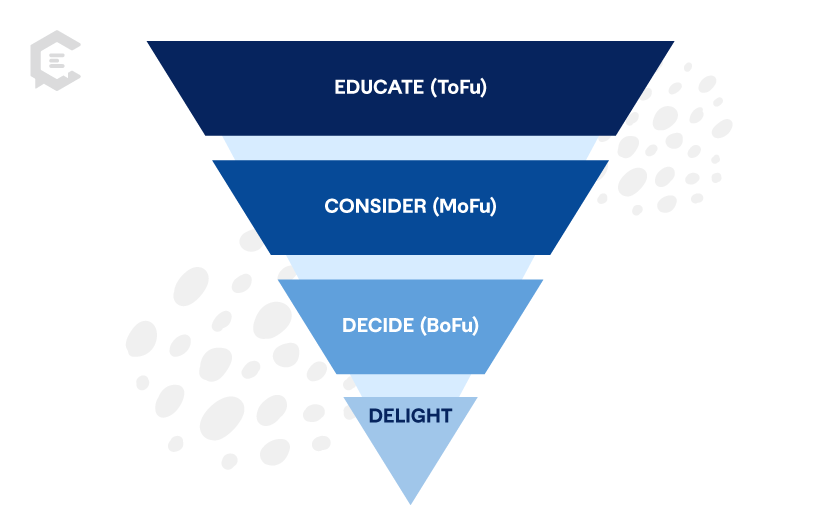Whether you’re a seasoned marketer or just starting out, understanding content marketing and how it can transform your brand’s online presence is essential in today’s digital landscape. In this glossary piece, we’ll dive deep into the world of content marketing and explore its incredible potential for your business.

What is content marketing?
Content marketing is creating and sharing content designed to attract and engage a target audience. That content can take various forms, such as:
- Blog posts
- Videos
- Infographics
- Social media
- eBooks
- Whitepapers
Content marketing designs your content to build trust, establish your brand as an authority, and ultimately drive profitable customer action. By crafting compelling and valuable content, you can connect with your audience on a deeper level, build long-term relationships, and influence their purchasing decisions.
Why is content marketing important?
Attention is the most valuable resource in the digital landscape. And that’s where content marketing shines. By consistently delivering high-quality content, you can cut through all the digital noise and capture the attention of your target audience.
Content marketing establishes your brand as a trusted source of information and a solution provider. This not only builds credibility and loyalty, it also boosts brand visibility and drives conversions. Content marketing empowers you to create meaningful connections with your audience, nurture relationships, and grow your business. It’s the fuel that powers your digital presence and propels you toward long-term success.
Plus, 69% of businesses are increasing their 2023 content marketing budget.
Common Types of Content Marketing
Every piece of content is the start of a conversation with your target audience. What you bring to the conversation matters, so you need to put your best foot forward with relevant and useful content. How will you use a mixture of content to reach your future customer, lend support, and leave a lasting impression? To help you align your content with the buyer journey stages, organize your content types into four stages:
- Educate/Top-of-Funnel (ToFu)
- Consider/Middle-of-Funnel (MoFu)
- Decide/Bottom-of-Funnel (BoFu)
- Delight/Beyond the Funnel
Some content types are more resource-intensive and time-consuming. Be hopeful and enthusiastic about producing content, but also be a realist.
For example, video content can be incredibly engaging — if you have the means to hire these resources. You also need a strategy in place to ensure the videos are being deployed most effectively.
A more practical approach might be cranking out unique blog content instead because you have skilled writers on your team and/or you can afford to have your content managed fully externally.
Next, let’s explore the inner workings of content marketing, with more about what to do and what not to do.
Five Content Marketing Do’s
1. Do align your content with the buyer stages
You probably got the memo by now, but understanding how your content falls into the buyer’s journey is seriously important. Pushing late-stage content when a buyer is still in the early stage will be a turn-off. These are the buyer stages:
- Educate
- Consider
- Decide
- Delight
The goal with each is identical — prioritize your buyer’s needs from the first interaction with your brand until they decide to become your customer. Then keep empowering their success.
2. Do create content for each of your personas
Personas are marketing code for “knowing your audience.” A buyer persona development exercise will help your content marketing team produce relevant content that resonates with each unique buyer.
3. Do optimize everything
The higher your content ranks, the more traffic you get. And this is a crowded content world. To stand out, your content needs to rank well. From topic keyword research to on-page optimization, following SEO best practices improve content relevance, increases performance, and attracts and converts qualified leads over time.
4. Do know what type of content writer you need
To fulfill your content vision, it takes content writers who specialize. Asking a social media rock star to write a long-form piece will not work well for anyone. Make sure to work with a writer that can match your needs. Below are the most popular types of content writers:
- Blog writer
- Brand journalist
- Copywriter
- Ghostwriter
- Technical writer
- Social media writer
- Email writer
- Scriptwriter
- Long-form content writer
- Ad and promo writer
5. Do leverage all the data
Leveraging data is one of the most important tools in your content marketing strategy. It enables you to understand what content resonates most with your target market, allowing you to tailor your strategies for maximum impact.
Five Content Marketing Don’ts
1. Don’t create self-serving content
Do you want to read a 1,000-word advertisement? Neither does anyone else. If you follow the do’s we just covered, you will be golden. You know who your buyers are and how to speak to them, so create something they want to see and hear.
2. Don’t produce anything without a content strategy
There are so many approaches to building a content strategy. The point is… have one! Without a plan, you will flounder — and eventually — fail. You must align your team and efforts around your big-picture strategy. A big misconception is that an editorial calendar is a content strategy. It’s not the strategy; it’s the execution of that strategy.
3. Don’t brainstorm topics alone or in silos
Two heads are better than one, so don’t approach content topics alone or in silos. Enlist subject matter experts within your organization and customers and thought leaders outside your organization.
4. Don’t forget to break up content visuals
Too much text jumbled together is brutal. And people have an insanely short attention span. Even if you do all the right things by optimizing and promoting your content, you still need to keep people engaged on the page. Visual content — whether images, infographics, or videos — are a great way to bring in some eye candy.
5. Don’t sabotage your content efforts
They call it a “content machine” for a reason. You must keep fuel in the engine, or it will stop working. Content marketing will quickly overwhelm even the brightest, most capable marketing teams. Make sure you keep asking questions like:
- Am I publishing sporadically because I’m taking on more than I can handle?
- Am I pushing forward and forgetting to celebrate the wins?
- Am I doing one-and-done content pieces instead of repurposing?
- Am I sharing content once, and that’s it?
- Am I choosing isolation over collaboration?
- Am I chasing my tail instead of working ahead?
- Am I in a feverish state of failure instead of feeling accomplished?
Taking Your Content Marketing to the Next Level
There are so many layers when it comes to the definition of content marketing. But we always come back to one word. Conversation. And the same way you converse with other humans is the same way you should speak with your customers.
Creating and implementing a content marketing strategy can feel overwhelming at first. Luckily, at ClearVoice, we have a massive Talent Network vetted and managed to execute all your content marketing needs. Talk to a content specialist today to find out how we can take your content marketing to the next level.








